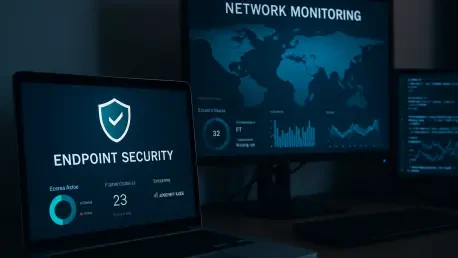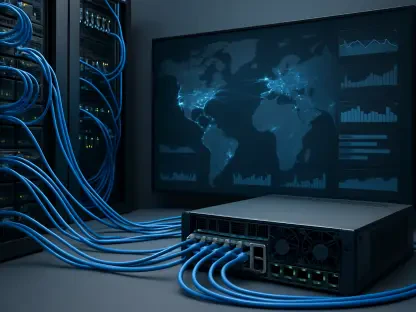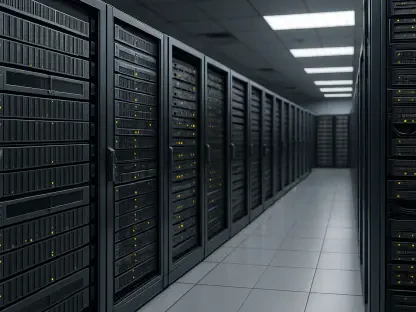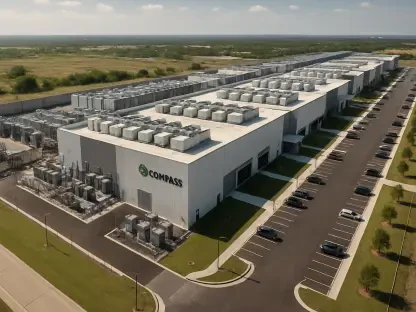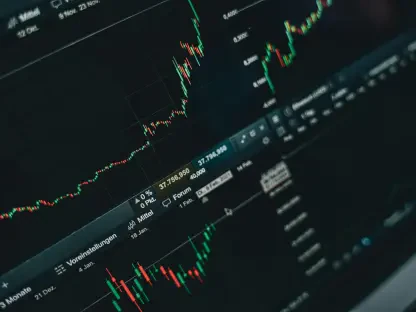In an era where cyber threats evolve at an unprecedented pace, the cybersecurity landscape is witnessing a remarkable transformation, particularly in endpoint security and network monitoring, driven by the urgent need to safeguard digital assets against sophisticated attacks. This urgency has propelled the industry into a race for innovation, with recent developments showcasing the pivotal role of artificial intelligence (AI) and cloud-based solutions. The week of September 26th marked a significant moment as leading vendors unveiled groundbreaking tools and strategies to address the growing complexity of IT environments. From automated threat detection to enhanced visibility across hybrid systems, companies like Darktrace, WatchGuard Technologies, and Sumo Logic are redefining how organizations defend against adversaries. This surge of advancements not only highlights the industry’s adaptability but also its commitment to staying one step ahead of malicious actors. As these technologies become more accessible, the implications for businesses of all sizes are profound, setting the stage for a deeper exploration of the trends driving this critical field forward.
Harnessing AI for Next-Generation Cybersecurity
The integration of artificial intelligence into cybersecurity frameworks is no longer a novelty but a fundamental shift reshaping endpoint security and network monitoring. AI-driven tools are being deployed to automate mundane tasks, detect threats in real time, and accelerate incident response, fundamentally changing how security teams operate. Darktrace’s latest automated cloud forensics solution, integrated with its Darktrace / CLOUD platform, stands as a prime example of this trend, offering immediate detection and detailed investigation capabilities across multi-cloud environments. Sumo Logic’s Dojo AI, leveraging Amazon Web Services, further illustrates this by employing specialized agents to streamline complex security investigations. These advancements underscore a critical reality: the sheer volume and sophistication of modern threats demand intelligent automation to maintain effective defenses, pushing AI to the forefront of security innovation.
Beyond automation, AI is emerging as a vital defense mechanism against adversaries who are themselves harnessing similar technologies for malicious purposes. The industry consensus points to an urgent need to weaponize AI for protective measures, as highlighted by expert discussions on platforms like “The Cyber Circuit.” This dual nature of AI—as both a shield and a potential vulnerability—requires careful governance to prevent misuse while maximizing its benefits. The rapid adoption of these tools reflects a broader recognition that traditional security approaches fall short against AI-driven attacks, necessitating a proactive stance. As vendors continue to refine these capabilities, the focus remains on balancing efficiency with oversight, ensuring that organizations can leverage AI’s power without exposing themselves to unintended risks. This balance is crucial for building resilient systems capable of withstanding the evolving threat landscape.
Cloud and Hybrid Environments Redefine Security Strategies
The migration to cloud and hybrid IT environments has fundamentally altered the design and deployment of security solutions, reflecting the dispersed nature of modern digital assets. With data and applications spanning on-premises, cloud, and hybrid platforms, vendors are prioritizing comprehensive strategies that ensure seamless protection across these diverse setups. WatchGuard Technologies’ FireCloud Total Access, a hybrid Secure Access Service Edge (SASE) solution, exemplifies this shift by making zero-trust security accessible to managed service providers and smaller IT teams. This move away from enterprise-exclusive models addresses the needs of today’s distributed workforces, where remote and hybrid work arrangements are commonplace. By offering scalable, cloud-delivered tools, the industry is adapting to the reality of fragmented infrastructures, ensuring that protection is not limited by location or scale.
Further emphasizing this trend, Darktrace’s advancements in multi-cloud forensics highlight the importance of unified security postures that can detect and investigate threats regardless of their origin. These solutions tackle the inherent challenges of managing security in environments where traditional boundaries no longer apply, providing real-time insights and responses. The push toward cloud-centric strategies is a direct response to the growing complexity of safeguarding digital ecosystems, where a single vulnerability can compromise an entire network. As more organizations adopt hybrid models, the demand for integrated, flexible security tools continues to rise, driving innovation in how threats are identified and mitigated. This evolution signals a broader industry acknowledgment that protecting modern IT landscapes requires a holistic approach, bridging gaps between disparate systems to create a cohesive defense mechanism.
Prioritizing Visibility and Integration for Robust Defense
As the adoption of AI and cloud technologies accelerates, the need for enhanced visibility and governance has become a central focus for endpoint security and network monitoring. Secure Code Warrior’s beta program for Trust Agent: AI addresses the emerging risks associated with AI coding tools by offering traceability and oversight, a growing concern for Chief Information Security Officers tasked with managing developer activities. Similarly, Titania’s updates to its Continuous Threat Exposure Management solution provide compliance dashboards aligned with real-world adversary tactics, empowering security teams with contextual insights into network misconfigurations. These developments reflect a critical industry priority: ensuring that rapid technological advancements do not outpace the ability to monitor and control them, thereby preventing potential vulnerabilities from being exploited in increasingly complex environments.
Integration across platforms is another key pillar in strengthening cybersecurity frameworks, as demonstrated by Keeper Security’s collaboration with Google Security Operations to centralize privileged access activity for improved control. Progress Software’s Flowmon ADS 12.5 also contributes to this narrative by introducing AI-powered threat briefings and enhanced event visualizations to simplify incident handling. These efforts to create cohesive security workflows highlight the importance of interoperability, enabling organizations to manage threats more effectively across their entire digital ecosystem. By unifying disparate tools and data sources, vendors are addressing the fragmentation that often undermines security efforts, ensuring that critical information is accessible when and where it is needed most. This focus on integration and visibility is essential for building robust defenses capable of adapting to the dynamic nature of cyber threats.
Strategic Shifts and Accessibility Shape the Future
Strategic leadership changes and a push toward accessibility are shaping the trajectory of cybersecurity innovation, positioning the industry for rapid growth and broader impact. Gigamon’s recent executive updates, including key appointments in AI security and operations, signal a deliberate effort to scale the adoption of AI-powered deep observability solutions. Such moves indicate a forward-looking approach, preparing vendors to meet the escalating demands of an increasingly digital world where threats evolve at breakneck speed. This focus on organizational agility ensures that companies can innovate quickly, delivering cutting-edge tools that address emerging challenges while maintaining a competitive edge in a crowded market. The emphasis on leadership reflects a broader trend of aligning internal structures with the fast-paced nature of technological advancement.
Equally significant is the industry’s commitment to democratizing advanced security solutions, making them available to a wider range of organizations beyond just large enterprises. WatchGuard Technologies’ efforts to target managed service providers and lean IT teams with scalable SASE offerings exemplify this shift, breaking down barriers that have historically limited access to robust security tools. This trend toward inclusivity recognizes the diverse needs of today’s businesses, many of which operate with constrained resources yet face the same sophisticated threats as larger counterparts. By prioritizing affordability and ease of deployment, vendors are enabling smaller organizations to bolster their defenses, fostering a more resilient digital landscape overall. This accessibility is a crucial step toward ensuring that cybersecurity advancements benefit all, not just a select few.
Reflecting on a Pivotal Moment in Cybersecurity
Looking back at the wave of announcements from the week of September 26th, it became evident that the cybersecurity industry had reached a turning point, balancing groundbreaking innovation with the pressing need for robust governance. The pervasive adoption of AI, the strategic pivot to cloud and hybrid solutions, and the heightened focus on visibility and accessibility painted a picture of an adaptive, forward-thinking field. Each vendor, from Darktrace to Sumo Logic, contributed unique perspectives through automated forensics, integrated platforms, and scalable tools, yet all shared a common goal of proactive defense. Moving forward, organizations should consider investing in AI-driven technologies while establishing strict oversight to mitigate risks. Additionally, embracing hybrid security models and fostering interoperability across systems will be key to addressing modern IT complexities. As the threat landscape continues to evolve, staying agile and prioritizing integrated, accessible solutions will remain essential for safeguarding digital assets against relentless adversaries.
